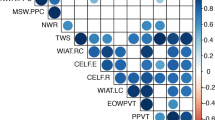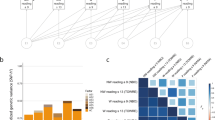Abstract
Specific language impairment is a developmental language disorder characterized by failure to develop language normally in the absence of a specific cause. Previous twin studies have documented the heritability of reading and language measures as well as the genetic correlation between those measures. This paper presents results from an alternative to the classical twin designs by estimating heritability from extended pedigrees. These pedigrees were previously studied as part of series of molecular genetic studies of specific language impairment where the strongest genetic findings were with reading phenotypes rather than language despite selecting pedigrees based on language impairments. To explore the relationship between reading and language in these pedigrees, variance components estimates of heritability of reading and language measures were conducted showing general agreement with the twin literature, as were genetics correlations between reading and language. Phonological short-term memory, phonological awareness and auditory processing were evaluated as candidate mediators of the reading-language genetic correlations. Only phonological awareness showed significant genetic correlations with all reading measures and several language measures while phonological short-term memory and auditory processing did not.
Similar content being viewed by others
References
Allison DB, Neale MC, Zannolli R, Schork NJ, Amos CI, Blangero J (1999) Testing the robustness of the likelihood-ratio test in a variance-component quantitative-trait loci-mapping procedure. Am J Hum Genet 65(2):531–544
Almasy L, Blangero J (1998) Multipoint quantitative-trait linkage analysis in general pedigrees. Am J Hum Genet 62(5):1198–1211
Bartlett CW, Flax JF, Logue MW, Vieland VJ, Bassett AS, Tallal P, Brzustowicz LM (2002) A major susceptibility locus for specific language impairment is located on 13q21. Am J Hum Genet 71(1):45–55
Bartlett CW, Flax JF, Logue MW, Smith BJ, Vieland VJ, Tallal P, Brzustowicz LM (2004) Examination of potential overlap in autism and language loci on chromosomes 2, 7, and 13 in two independent samples ascertained for specific language impairment. Hum Hered 57(1):10–20
Bates TC, Castles A, Luciano M, Wright M, Coltheart M, Martin N (2007) Genetic and environmental bases of reading and spelling: a unified genetic dual route model. Read Writ 20:147–171
Bishop DV (2001) Individual differences in handedness and specific speech and language impairment: evidence against a genetic link. Behav Genet 31(4):339–351
Bishop DV, Snowling MJ (2004) Developmental dyslexia and specific language impairment: same or different? Psychol Bull 130(6):858–886
Bishop DV, North T, Donlan C (1995) Genetic basis of specific language impairment: evidence from a twin study. Dev Med Child Neurol 37(1):56–71
Bishop DV, North T, Donlan C (1996) Nonword repetition as a behavioural marker for inherited language impairment: evidence from a twin study. J Child Psychol Psychiatr 37(4):391–403
Bishop DV, Bishop SJ, Bright P, James C, Delaney T, Tallal P (1999) Different origin of auditory and phonological processing problems in children with language impairment: evidence from a twin study. J Speech Lang Hear Res 42(1):155–168
Bishop DV, Adams CV, Norbury CF (2004) Using nonword repetition to distinguish genetic and environmental influences on early literacy development: a study of 6-year-old twins. Am J Med Genet B Neuropsychiatr Genet 129B(1):94–96
Bishop DV, McDonald D, Bird S, Hayiou-Thomas ME (2009) Children who read words accurately despite language impairment: who are they and how do they do it? Child Dev 80(2):593–605
Blangero J, Williams JT, Almasy L (2000) Robust LOD scores for variance component-based linkage analysis. Genet Epidemiol 19(Suppl 1):S8–S14
Byrne B, Wadsworth S, Corley R, Samuelsson S, Quain P, DeFries JC, Willcutt E, Olson RK (2005) Longitudinal twin study of early literacy development: preschool and kindergarten phases. Sci Stud Read 9:219–235
Catts HW, Adlof SM, Hogan TP, Weismer SE (2005) Are specific language impairment and dyslexia distinct disorders? J Speech Lang Hear Res 48(6):1378–1396
Corriveau K, Pasquini E, Goswami U (2007) Basic auditory processing skills and specific language impairment: a new look at an old hypothesis. J Speech Lang Hear Res 50(3):647–666
Gathercole SE, Willis CS, Baddeley AD, Emslie H (1994) The children’s test of nonword repetition: a test of phonological working memory. Memory 2(2):103–127
Gayan J, Olson RK (2003) Genetic and environmental influences on individual differences in printed word recognition. J Exp Child Psychol 84(2):97–123
Hammil DD, Newcomer PL (1988) Test of language development-2, intermediate. Pro-Ed, Austin, TX
Hammil DD, Brown VL, Larsen SC, Wiederhold JL (1987) Test of adolescent language-2. Pro-Ed, Austin, TX
Harlaar N, Dale PS, Plomin R (2007) From learning to read to reading to learn: substantial and stable genetic influence. Child Dev 78(1):116–131
Harlaar N, Hayiou-Thomas ME, Dale PS, Plomin R (2008) Why do preschool language abilities correlate with later reading? A twin study. J Speech Lang Hear Res 51(3):688–705
Haworth CM, Kovas Y, Harlaar N, Hayiou-Thomas ME, Petrill SA, Dale PS, Plomin R (2009) Generalist genes and learning disabilities: a multivariate genetic analysis of low performance in reading, mathematics, language and general cognitive ability in a sample of 8000 12-year-old twins. J Child Psychol Psychiatr 50(10):1318–1325
Haworth CM, Wright MJ, Luciano M, Martin NG, de Geus EJ, van Beijsterveldt CE, Bartels M, Posthuma D, Boomsma DI, Davis OS, Kovas Y, Corley RP, Defries JC, Hewitt JK, Olson RK, Rhea SA, Wadsworth SJ, Iacono WG, McGue M, Thompson LA, Hart SA, Petrill SA, Lubinski D, Plomin R (2010) The heritability of general cognitive ability increases linearly from childhood to young adulthood. Mol Psychiatr 15(11):1112–1120
Jacquard A (1974) The genetic structure of populations. Springer-Verlag, New York
Kamhi AG, Catts HW (1986) Toward an understanding of developmental language and reading disorders. J Speech Hear Disord 51(4):337–347
Kovas Y, Hayiou-Thomas ME, Oliver B, Dale PS, Bishop DV, Plomin R (2005) Genetic influences in different aspects of language development: the etiology of language skills in 4.5-year-old twins. Child Dev 76(3):632–651
Levelt WJM, Roelofs A, Meyer AS (1999) A theory of lexical access in speech production. Behav Brain Sci 22:1–75
Lewis BA, Thompson LA (1992) A study of developmental speech and language disorders in twins. J Speech Hear Res 35(5):1086–1094
McArthur GM, Hogben JH, Edwards VT, Heath SM, Mengler ED (2000) On the “specifics” of specific reading disability and specific language impairment. J Child Psychol Psychiatr 41(7):869–874
Neils J, Aram DM (1986) Family history of children with developmental language disorders. Percept Mot Skills 63(2 Pt 1):655–658
Newbury DF, Winchester L, Addis L, Paracchini S, Buckingham LL, Clark A, Cohen W, Cowie H, Dworzynski K, Everitt A, Goodyer IM, Hennessy E, Kindley AD, Miller LL, Nasir J, O’Hare A, Shaw D, Simkin Z, Simonoff E, Slonims V, Watson J, Ragoussis J, Fisher SE, Seckl JR, Helms PJ, Bolton PF, Pickles A, Conti-Ramsden G, Baird G, Bishop DV, Monaco AP (2009) CMIP and ATP2C2 modulate phonological short-term memory in language impairment. Am J Hum Genet 85(2):264–272
Newcomer PL, Hammil DD (1988) Test of language development-2, primary. Pro-Ed, Austin, TX
Olson R, Wise B, Conners F, Rack J, Fulker D (1989) Specific deficits in component reading and language skills: genetic and environmental influences. J Learn Disabil 22(6):339–348
Petrill SA, Deater-Deckard K, Thompson LA, DeThorne LS, Schatschneider C (2006) Genetic and environmental effects of serial naming and phonological awareness on early reading outcomes. J Educ Psychol 98:112–121
Petrill SA, Deater-Deckard K, Thompson LA, Schatschneider C, Dethorne LS, Vandenbergh DJ (2007) Longitudinal genetic analysis of early reading: the Western Reserve reading project. Read Writ 20(1–2):127–146
Plomin R, Kovas Y (2005) Generalist genes and learning disabilities. Psychol Bull 131(4):592–617
Rao DC, Vogler GP, Borecki IB, Province MA, Russell JM (1987) Robustness of path analysis of family resemblance against deviations from multivariate normality. Hum Hered 37(2):107–112
Rice ML, Haney KR, Wexler K (1998) Family histories of children with SLI who show extended optional infinitives. J Speech Lang Hear Res 41(2):419–432
Rice ML, Smith SD, Gayan J (2009) Convergent genetic linkage and associations to language, speech and reading measures in families of probands with specific language impairment. J Neurodev Disord 1(4):264–282
Rosner J (1979) Test of auditory analysis akills (TAAS). Academic Therapy Publications, Novato
Schiller NO, Jansma BM, Peters J, Levelt WJM (2006) Monitoring metrical stress in polysyllabic words. Lang Cognitive Proc 21(1/2/3):112–140
Self SG, Liang KY (1987) Asymptotic properties of maximum likelihood estimators and likelihood ratio tests under nonstandard conditions. J Am Stat Assoc 82(398):605–610
Simmons TR, Flax JF, Azaro MA, Hayter JE, Justice LM, Petrill SA, Bassett AS, Tallal P, Brzustowicz LM, Bartlett CW (2010) Increasing genotype-phenotype model determinism: application to bivariate reading/language traits and epistatic interactions in language-impaired families. Hum Hered 70(4):232–244
Snowling MJ (1981) Phonemic deficits in developmental dyslexia. Psychol Res 43(2):219–234
Stromswold K (1998) Genetics of spoken language disorders. In human biology. Wayne State University Press, Detroit Michigan, pp 293–320
Stromswold K (2000) The cognitive neuroscience of language acquisition. In: Gazzaniga M (ed) The new cognitive neurosciences. MIT Press, Cambridge, pp 909–932
Stromswold K (2001) The heritability of language: a review and metaanalysis of twin adoption and linkage studies. Language 77(4):647–723
Tallal P, Piercy M (1973a) Developmental aphasia: impaired rate of non-verbal processing as a function of sensory modality. Neuropsychologia 11(4):389–398
Tallal P, Piercy M (1973b) Defects of non-verbal auditory perception in children with developmental aphasia. Nature 241(5390):468–469
Tallal P, Piercy M (1974) Developmental aphasia: rate of auditory processing and selective impairment of consonant perception. Neuropsychologia 12(1):83–93
Tallal P, Piercy M (1975) Developmental aphasia: the perception of brief vowels and extended stop consonants. Neuropsychologia 13(1):69–74
Tallal P, Stark RE, Kallman C, Mellits D (1980) Developmental dysphasia: relation between acoustic processing deficits and verbal processing. Neuropsychologia 18(3):273–284
Tallal P, Ross R, Curtiss S (1989) Familial aggregation in specific language impairment. J Speech Hear Disord 54(2):167–173
Tallal P, Merzenich MM, Miller S, Jenkins W (1998) Language learning impairments: integrating basic science, technology, and remediation. Exp Brain Res 123(1–2):210–219
Tomblin JB (1989) Familial concentration of developmental language impairment. J Speech Hear Disord 54(2):287–295
Tomblin JB, Buckwalter PR (1998) Heritability of poor language achievement among twins. J Speech Lang Hear Res 41(1):188–199
Vernes SC, Macdermot KD, Monaco AP, Fisher SE (2009) Assessing the impact of FOXP1 mutations on developmental verbal dyspraxia. Eur J Hum Genet 17:1354–1358
Wechsler D (1974) Wechsler intelligence scale for children-revised. The Psychological Corporation, San Antonio
Wechsler D (1981) Wechsler adult intelligence scale-revised. The Psychological Corporation, San Antonio
Wechsler D (1989) Wechsler pre-school and primary scale of intelligence-revised. The Psychological Corporation, San Antonio
Wechsler D (1999) Wechsler abbreviated scale of intelligence. The Psychological Corporation, San Antonio
Woodcock RW (1987) Woodcock reading mastery tests-revised. American Guidance Service, Inc, Minnesota
Acknowledgments
We would like to thank the participating families whose time and cooperation made this work possible; T Realpe-Bonilla, J Nawyn, L Hirsch for family testing and database management; L Almasy for her helpful comments on the use of SOLAR for analysis. Family collection was supported by the National Institute on Deafness and other Communication Disorders R01 DC01654 (PT and LMB) and ongoing work is funded by R01 DC009453 (CWB, SAP and LMB). Paula Tallal is a founder of the Scientific Learning Corporation (http:\\WWW.SCIENTIFICLEARNING.COM).
Author information
Authors and Affiliations
Corresponding author
Additional information
Edited by Danielle Posthuma.
Rights and permissions
About this article
Cite this article
Logan, J., Petrill, S.A., Flax, J. et al. Genetic Covariation Underlying Reading, Language and Related Measures in a Sample Selected for Specific Language Impairment. Behav Genet 41, 651–659 (2011). https://doi.org/10.1007/s10519-010-9435-0
Received:
Accepted:
Published:
Issue Date:
DOI: https://doi.org/10.1007/s10519-010-9435-0




